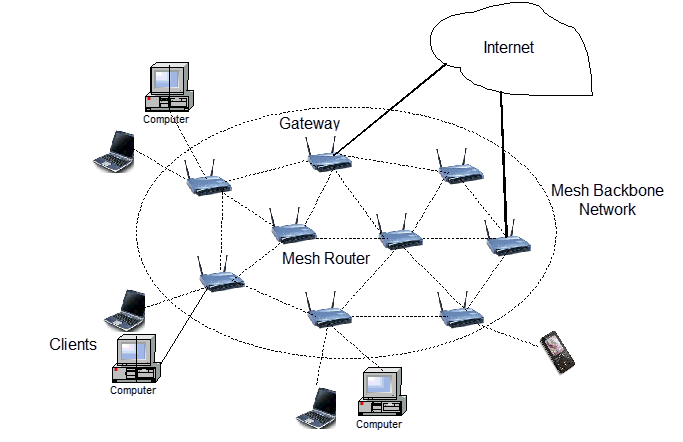
Research
Our research interests include the important issues and challenges in the area of wireless communications and networking. The focuses of our research are to design different protocols and algorithms in network, link and physical layers of different wireless networks and analyzing their efficiency in terms of different performance metrics. Our interests includes the following wireless networks. We are also interested to analyze the performance of different optical communication systems under the various non-linearity of fiber.
1. Wireless Local Area Networks
A WLAN consists of an Access Point (AP) and users, i.e, cellophanes, laptops and other devices. WLANs are widely deployed in homes, public hotspots, universities, offices and enterprises to provide high speed Internet access. WLANs have become popular in the home, public hotspots, offices and commercial complexes due to ease of installation. WLANs use IEEE 802.11 based CSMA/CA MAC protocol and MIMO OFDM technique. Multi-user MIMO based IEEE 802.11ac standard is in preparation to provide data rate up to 7 Gbps. Co-channel interference and contention of the nodes are the main problems for WLANs.
Our research focus is to analyze the performance of WLANs under the different advanced physical layer techniques and standards and optimize the performance of WLANs.
2. Wireless Mesh Networks
A wireless mesh network consists of gateways, mesh routers, and mesh clients. Wireless mesh networks are promising fixed wireless networks for future Internet services. Mesh routers and gateways are fixed and form a mesh backbone network to provide broadband access to the clients or other networks such as cellular networks and wireless local area networks (WLANs). Clients (static or mobile) are connected directly or through other networks to the routers or gateways of the mesh backbone network to access the Internet, while the Internet is connected to the gateways of the mesh backbone network through wireline or separate wireless links. Besides providing access to the Internet, the mesh backbone network also can provide client-to-client communication facility.
Providing quality of service (QoS) is crucial in wireless mesh networks. To provide QoS of the users, our research will focus on routing of heterogeneous traffic, medium access of the nodes, and application of the advanced physical layer techniques.
3. Wireless Vehicular Networks
Recently vehicular wireless networking has taken a significant research interest from the wireless research community. Traffic control and safety driving are the main purposes of the vehicular wireless networks. It is also expected that vehicular networks will provide Internet access to the passengers of cars. Two types of communications are proposed for vehicular networks: vehicle to vehicle (V2V) and vehicle to roadside unit (V2I).
[car-2-car.org]
Our research focus is to provide efficient algorithms for vehicular communication networks and to analyze the performance of the algorithms.
4. Wireless Cellular Networks
Wireless cellular networks are the mostly deployed wireless networks. To increase capacity from the limited frequency band, the base stations should place closer to the users. Heterogeneous cellular networks with macro, micro, pico and femto cells are being proposed for future cellular networks. The objectives of the next generation mobile cellular communications (5G) are to provide high throughput with low energy consumption through heterogeneous cellular architecture.
For cellular networks, we want to optimize the throughput and energy consumption of cellular networks under the different advanced physical layer techniques, e.g., cooperative communications, MU-MIMO, massive MIMO, successive interference cancellation, and cognitive radio etc.
5. Self-organizing Networks and Software Defined Radio Networks
Self-organizing and software defined radio access networks are promising networks in wireless networks described above. We also want to focus on these networks for research in future.
Home Background Research Teaching Students Contact